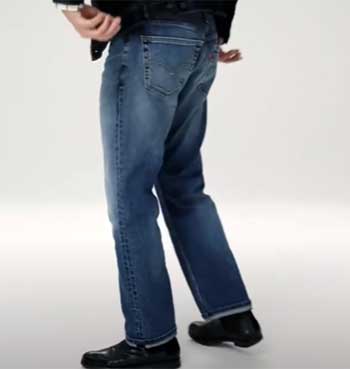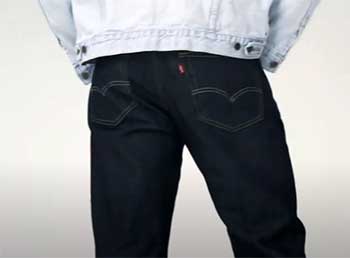If you’re in the market for a new pair of jeans, you may be wondering about the differences between two of Levi’s most popular styles – the 505 and 559. Both are classic straight-leg jeans with a regular rise and straight-leg opening.
However, some key differences make each style unique.
In this comprehensive guide, we’ll break down the fit, feel, and features of Levi’s 505 and 559 jeans to help you decide which pair is the right one for you. We’ll look at the pros and cons of each style, do a side-by-side comparison, and answer some frequently asked questions.
Let’s get started!
Side-by-Side Comparison Table
Here is a side-by-side overview of the key differences between the Levi’s 505 and 559 jeans:
| Feature | Levi’s 505 | Levi’s 559 |
| Rise | Sits at natural waist | Sits below waist |
| Fit | Relaxed through seat and thigh | Roomy in hip and thigh |
| Leg Opening | Straight | Wider straight |
| Denim Weight | 12-16 oz., mid to heavy | 11-13 oz. with stretch |
| Wash | Dark indigo | Medium indigo |
| Style | Classic, vintage workwear | Modern, updated |
Levi’s 505 Jeans – Key Features and Details

- High rise that sits at the natural waist
- Relaxed fit through hip, thigh and leg
- Wide straight leg opening
- 5 pocket styling
- Zip fly and button closure
- Rivets at points of strain
- Mid to heavyweight non-stretch denim
- Vintage look with wear patterns
The 505 is made from rigid, shrink-to-fit denim.
Most pairs use a 12-16 oz. fabric that softens over time.
This creates that perfectly broken-in feel.
They have a generous fit through the hip and thigh with ample room in the seat. The wide straight leg can be worn hemmed to bootcut or rolled for a casual cuff.
This classic five pocket style comes in traditional Levi’s washes. Fading and whiskering give a worn-in appearance right off the shelf.
Overall, the 505 has a relaxed, baggy silhouette rooted in workwear. The lack of stretch supports the joints when moving. Levi’s trusted construction allows them to last for years.
Also Read: Comparison of Levi’s 550 And 569 Jeans.
Overview of the Levi’s 559 Jeans
- Sits below the waist with mid rise
- Roomy through hip and thigh
- Gentle taper to straight leg
- Added stretch for flexibility
- 5 pocket styling
- Smooth sculpting and contouring
- Zip fly and button closure
- 11-13 oz. denim in modern washes

Levi’s 559 jeans use part elastic fabrics to provide stretch and recovery.
This prevents sagging while accommodating movement.
The mid rise offers just enough coverage without restricting mobility.
The hip and thighs have extra space perfect for athletic builds.
Gentle shaping through the seat streamlines the straight fit.
The tapered leg opening modernizes the silhouette.
The 559 often uses a rich medium indigo wash. White and black levels vary between clean and heavily stained appearances.
Overall, the 559 takes that legendary Levi’s jean appeal and modifies it to current preferences. The stretch material and contoured fit create a flattering, adaptive shape.
Comparing Key Differences of Levi’s 505 And 559 Jeans
While both are straight fit jeans, the 505 and 559 do have distinct styling differences:
- The 505 has a high rise compared to the mid rise 559
- 505 uses heavyweight rigid denim versus 559’s lighter stretch
- 505 is relaxed through hip/thigh, 559 is roomy with shaping
- 505 leg opening is wider than the tapered 559
- 505 comes in classic washes, 559 has modern finishes
So with the same basic jean design, Levi’s tailored each one to contrasting eras and aesthetics. Now let’s examine the pros and cons.
Pros and Cons of Levi’s 505 Jeans
Pros
- Timeless vintage appearance
- Durable heavyweight denim
- Loose comfortable fit
- No stretching out over time
- Easy to break-in yourself
- Great for casual rugged outfits
Cons
- Restrictive without stretch
- Can sag after prolonged wear
- Limited modern washes and colors
- Hip/thigh fit too loose for some
- Needs to be hemmed for clean finish
Also Read: Comparison of Levi’s 504 And 505 Straight Leg Denim Jeans.
Pros and Cons of Levi’s 559 Jeans
Pros

- Added stretch for better mobility
- More space in hip and thigh than classic fits
- Tapered leg for polished silhouette
- Updated washes for contemporary look
- Contouring provides support and shape
- Works well for athletic body types
Cons
- Less durable stretch denim
- Limited rise options
- Potential fit inconsistencies
- Less vintage workwear character
- May lose structure over time
As you can see, both these Levi’s jeans have their advantages and disadvantages depending on your needs. Next we’ll compare them across some key factors.
Comfort and Fit Comparison of Levi’s 505 And 559 Jeans
- Comfort
The 505 offers exceptional comfort once broken in. The rigid denim forms to your body over time. The generous hip and thigh space allows for free range of motion.
The 559 has immediate comfort right off the shelf. The elasticity lets them move with you while the contouring prevents restriction.
For all-day wear, the 559’s stretch offers better comfort and retention. But the 505 can’t be beat for that worn-in feel.
- Fit
With its high rise and wide leg, the 505 has an old school baggy fit. It provides a relaxed, casual appearance.
The 559 combines a medium rise with a taper for a modern slim straight look. The stretch material helps achieve a clean, streamlined silhouette.
The 505 flatters most body types with its classic loose shape. The 559 is tailored for an athletic build.
Also Read: Differences Between Levi’s 531 And 511 Jeans.
Style and Appearance Comparison
- Style
505 jeans have a vintage utilitarian style thanks to traits like the visible selvedge line and retro washes. The faded denim gives them a worn-in workwear vibe.
559 jeans use modern washes and contemporary detailing for a current look. While still versatile, they have a more refined appearance than the rugged 505.
- Appearance
The 505 straight leg breaks over footwear for bunching and stacking effects. This can create sloppy creases without precise hemming.
The tapered 559 leg allows for a neater, straighter drape over shoes. The stretch material also gives a smoother front with fewer wrinkles and creases.
So the 505 embraces that classic Americana style while the 559 adapts it for today’s fashions.
Durability and Wear Comparison
- Durability
With heavyweight 12-16 oz. non-stretch denim, the 505 is extremely durable. The thick fabric stands up to regular wear and resists damage.
The 559 uses thinner stretch denim, usually 11-13 oz. While blended fabrics add longevity, they are less indestructible than rigid 100% cotton.
- Wear

The 505 jeans conform to the wearer’s shape over time.
Natural stress points fade and soften through repeated use.
559 jeans retain their shape better thanks to the elasticity.
With less natural wear patterns, they maintain construction longer before signs of damage emerge.
So the 505 ages gracefully with that salt-of-the-earth patina, while 559s require less breaking in for optimal wear.
Price and Value Comparison
Both the 505 and 559 provide excellent quality for price. Levi’s jeans are renowned for their construction.
The 505 usually costs slightly less than the 559. Current prices are:
- Levi’s 505 jeans – $59.50-$98.00
- Levi’s 559 jeans – $69.50-$120.00
For the lower cost, the 505 offers incredible value through durability and longevity. The 559 justify their higher price with performance features like shaping and stretch.
In terms of value over the lifespan, the 505 may come out ahead by lasting decades without major signs of wear. But the 559 provides amazing bang for your buck with its adaptive, comfortable fit.
Also Read: Differences Between Levi’s 502 And 511 Jeans.
Common Sizing Questions (FAQ)
Let’s answer some frequently asked sizing questions about Levi’s 505 and 559 jeans:
Yes, Levi’s 505 jeans are known for being comfortable, especially once broken in. The mid-to-heavyweight denim will soften up over time. The high rise is comfortable for all-day wear. The loose fit through the thigh allows for easy movement.
The 505 is the style name and number for this classic Levi’s jean. It refers specifically to the original straight leg model with the zip fly, high-rise, and relaxed fit.
The 559 jeans contain some spandex and stretch in the fabric, so they are less likely to shrink than 100% cotton denim. However, you may experience some slight shrinkage in the length after machine washing and drying. It’s best to wash the 559 jeans in cold water and dry on a low or delicate setting. You can also hang dry to prevent excessive shrinkage.
Yes, 505 jeans are preshrunk meaning they have already undergone the shrinkage process at the factory. This prevents the jeans from shrinking excessively when you wash them at home. You may notice some very minor shrinkage over time, but it will be minimal overall.
Wrapping Up
Levi’s 505 and 559 jeans share the same classic straight leg DNA but with noticeably different characteristics.
The 505 embodies that vintage Levi’s feel with its high rise, loose fit, and hardy denim. It’s the quintessential lived-in workwear jean that forms to your body.
The 559 provides a contemporary spin on the straight leg with its stretch fabric and modern washes. The roomy fit and taper add comfort and polish.
Overall, if you prioritize old school character and durability, go for the 505. If you want mobility and a current style, choose the 559. Both are quality jeans representing the past and future of this legendary brand.
We’ve covered the key fit, feature, style, sizing, and shrinkage differences between Levi’s 505 and 559 jeans. Hopefully this in-depth comparison helps you decide which straight fit icon is best for your wardrobe.



